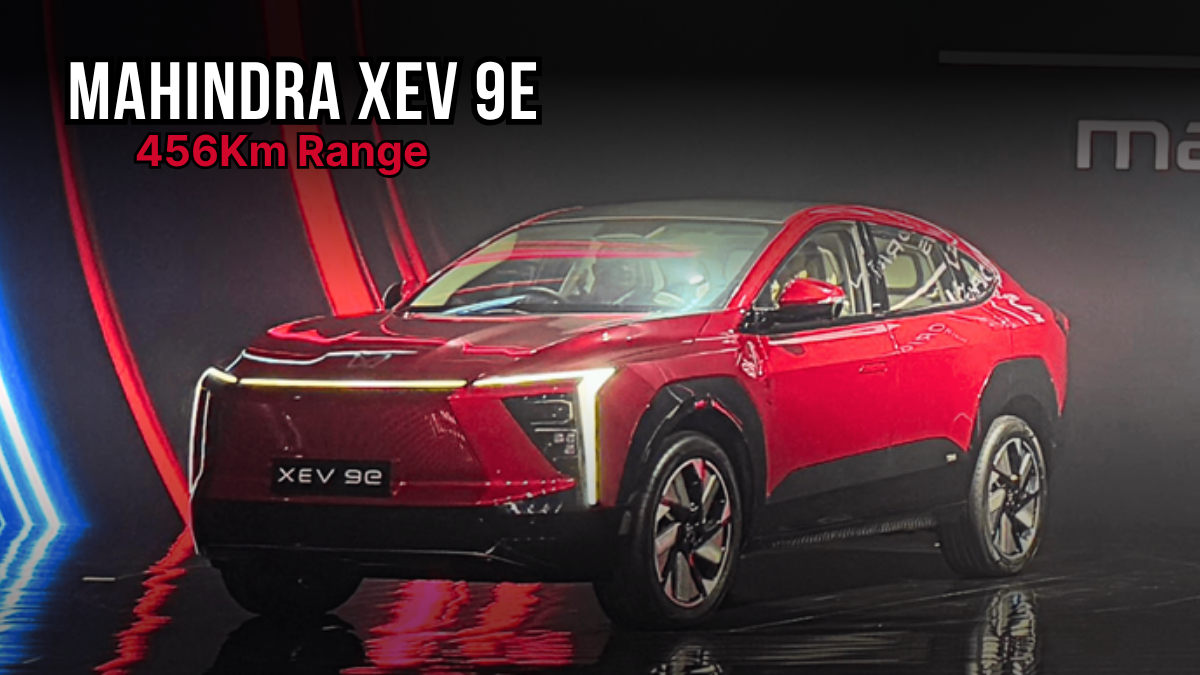Electric vehicle buyers often face a crucial question: how far can I actually drive on a single charge? While manufacturers provide impressive claimed ranges, real-world performance tells a different story. The Mahindra XEV 9e, with its 79kWh battery pack, promises 656km on paper but our comprehensive testing reveals what you can expect during daily driving.

Understanding the gap between claimed and actual range is essential for making informed EV purchasing decisions. This detailed analysis breaks down the XEV 9e’s performance across city streets and highways, helping potential buyers set realistic expectations for their electric driving experience.
Claimed vs Real-World Range: The Numbers Game
Mahindra positions the XEV 9e as a long-range electric SUV, with the 79kWh battery variant claiming an impressive 656km range based on India’s MIDC (Modified Indian Driving Cycle) testing standard. The WLTP (Worldwide Harmonized Light Vehicles Test Procedure) rating drops to 533km, while Mahindra suggests a real-world range exceeding 500km.
However, comprehensive testing reveals a more nuanced picture. The XEV 9e achieved a combined real-world range of 456km approximately 200km less than the MIDC claim. This 30% difference between claimed and actual performance reflects the gap between laboratory conditions and real-world driving scenarios.
The discrepancy stems from several factors that laboratory tests cannot fully replicate, including ambient temperature variations, traffic conditions, driving styles, and the constant use of climate control systems that consumers rely on daily.
City Driving Performance: Urban Reality Check
Urban driving presents unique challenges for electric vehicles, particularly in Indian conditions. The XEV 9e’s city performance reflects these real-world constraints, delivering 5.38km/kWh efficiency and translating to a practical range of 425km.
Several factors contribute to reduced city efficiency. The SUV’s substantial 2,201kg kerb weight requires more energy during frequent acceleration and deceleration cycles typical of urban traffic. Stop-and-go movement prevents the vehicle from maintaining optimal efficiency, while ambient temperatures reaching 40°C during testing placed additional strain on the battery and climate control systems.
The regenerative braking system, set to Level 3 during city testing, helps recover some energy during deceleration. However, the constant energy demands of urban driving including traffic light stops, parking maneuvers, and low-speed operation limit the overall efficiency gains from regenerative systems.
Despite these challenges, the 425km city range provides sufficient coverage for most urban users, supporting approximately one week of typical city commuting on a single charge.
Highway Efficiency: Long-Distance Capabilities
Highway driving conditions generally favor electric vehicles, allowing for more consistent speeds and reduced energy consumption. The XEV 9e demonstrates this advantage, achieving 6.18km/kWh efficiency on highway routes and delivering a real-world range of 488km.
The improved highway performance results from several factors. Constant speeds reduce the energy losses associated with frequent acceleration and deceleration. The regenerative braking system operates at Level 1 during highway driving, allowing the vehicle to coast more efficiently at higher speeds rather than constantly recovering energy.
Highway driving also eliminates the energy penalties associated with traffic congestion, parking, and low-speed maneuvering that characterize urban environments. The XEV 9e’s aerodynamic design contributes to highway efficiency, though the large SUV profile creates some wind resistance at higher speeds.
For long-distance travelers, the 488km highway range provides reasonable coverage for inter-city journeys, though charging infrastructure planning remains essential for extended trips.
Battery Technology and Charging Infrastructure
The XEV 9e utilizes LFP (Lithium Iron Phosphate) battery chemistry in its 79kWh pack, offering advantages in safety, thermal stability, and longevity compared to traditional lithium-ion alternatives. This chemistry choice reflects Mahindra’s focus on practical, long-term ownership rather than maximum energy density.
Charging capabilities support both AC and DC options, with DC fast charging reaching 175kW peak power. This allows 20% to 80% charging in approximately 20 minutes under optimal conditions, making the XEV 9e suitable for long-distance travel when fast charging infrastructure is available.
The vehicle supports multiple charging standards, including 16A portable charging for home use, 7.2kW and 11kW AC charging for overnight top-ups, and high-power DC charging for rapid replenishment during longer journeys.
Testing Methodology and Conditions
Professional range testing requires standardized conditions to ensure accurate, comparable results. The XEV 9e underwent comprehensive evaluation using controlled parameters that reflect real-world usage patterns.
Testing began with a fully charged battery and manufacturer-recommended tire pressures. The vehicle operated in its most efficient “Range” drive mode throughout testing, with climate control set to 22°C and fan speed on automatic conditions that mirror typical consumer usage.
The test route included fixed city and highway loops with maintained average speeds. All electrical systems, including audio, lighting, and ventilated seats, were used as needed to replicate normal driving conditions. Range calculations were based on actual charge consumption rather than estimated readings from the vehicle’s display.
This methodology provides consumers with realistic expectations for daily driving, accounting for the comfort features and environmental conditions they encounter regularly.
Competitive Landscape and Market Position
The XEV 9e competes in an increasingly crowded electric SUV segment, where range performance directly impacts purchasing decisions. Compared to similar offerings, the 456km real-world range positions the vehicle competitively for urban and suburban use.
The substantial difference between claimed and actual range reflects industry-wide challenges in communicating EV capabilities. While manufacturers must provide standardized test results, consumers benefit from understanding real-world performance under typical driving conditions.
The XEV 9e’s range performance supports most daily driving needs while requiring charging infrastructure awareness for longer journeys. This balance makes it suitable for consumers transitioning from conventional vehicles who need confidence in their daily mobility.
Practical Implications for Buyers
Range anxiety remains a significant concern for potential EV buyers, making real-world testing crucial for informed decision-making. The XEV 9e’s 456km combined range provides sufficient coverage for most daily driving scenarios while requiring occasional charging for extended use.
Urban users can expect approximately one week of typical commuting on a single charge, assuming daily distances of 50-70km. Highway travelers should plan charging stops for journeys exceeding 400km to maintain comfortable buffer margins.
The vehicle’s charging flexibility supports various usage patterns, from overnight home charging to rapid top-ups during longer trips. However, charging infrastructure availability remains a crucial consideration for potential buyers, particularly in regions with limited fast-charging networks.
Maximizing Your XEV 9e’s Range
Understanding your EV’s capabilities enables optimization strategies that can extend practical range. The XEV 9e offers multiple tools and techniques for maximizing efficiency during daily driving.
Drive mode selection significantly impacts range performance. The “Range” mode prioritizes efficiency over performance, adjusting throttle response and regenerative braking for optimal energy consumption. Eco-minded drivers should utilize this mode for daily commuting while reserving other modes for specific driving scenarios.
Regenerative braking levels can be adjusted based on driving conditions. Level 3 regeneration works well in city traffic, capturing energy during frequent deceleration. Highway driving benefits from Level 1 regeneration, allowing the vehicle to coast more efficiently at consistent speeds.
Climate control represents one of the largest energy consumers in electric vehicles. Pre-conditioning the cabin while plugged in, using seat heating instead of cabin heating, and maintaining moderate temperature settings can significantly extend range.
FAQs: Frequently Asked Questions
Q1. What is the claimed range of the Mahindra XEV 9e?
The Mahindra XEV 9e has a claimed range of 656km as per official specifications.
Q2. What was the real-world range achieved during testing?
The real-world testing revealed a range of 456km under mixed driving conditions, showcasing its practical performance.
Q3. How does the range vary between city and highway driving?
The range tends to be higher in city conditions due to regenerative braking, while highway driving may result in a slightly reduced range due to sustained high speeds.
Q4. What factors can impact the real-world range of the Mahindra XEV 9e?
Factors such as driving style, road conditions, temperature, and use of air conditioning or heating can significantly influence the real-world range.
Q5. Is the range sufficient for long trips?
With a real-world range of 456km, the vehicle can manage long trips with planned charging stops, making it a practical choice for such journeys.
The Road Ahead for Electric Range
Real-world range testing reveals both the capabilities and limitations of current electric vehicle technology. The XEV 9e’s performance demonstrates that modern EVs can support most daily driving needs while highlighting the importance of realistic expectations and charging infrastructure.
As battery technology continues improving and charging networks expand, the gap between claimed and real-world range will likely narrow. However, understanding current capabilities helps consumers make informed decisions about electric vehicle adoption.
The XEV 9e’s 456km real-world range represents a practical compromise between cost, weight, and performance. For buyers seeking an electric SUV that can handle daily commuting and occasional longer trips, this range provides sufficient capability with appropriate charging planning.
For More Information CLICK




